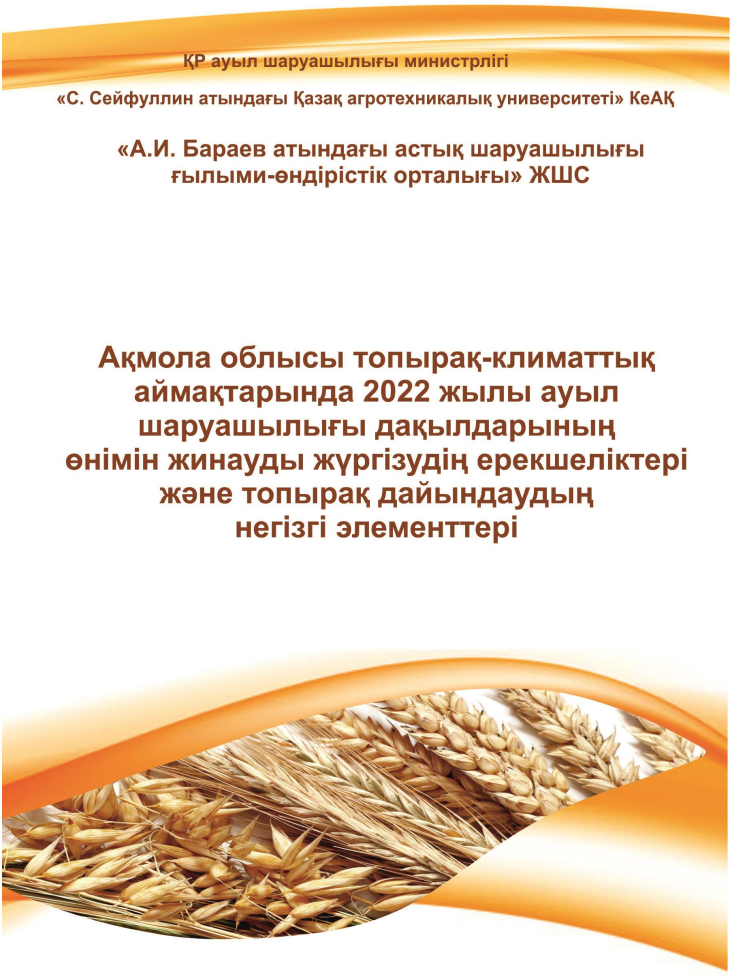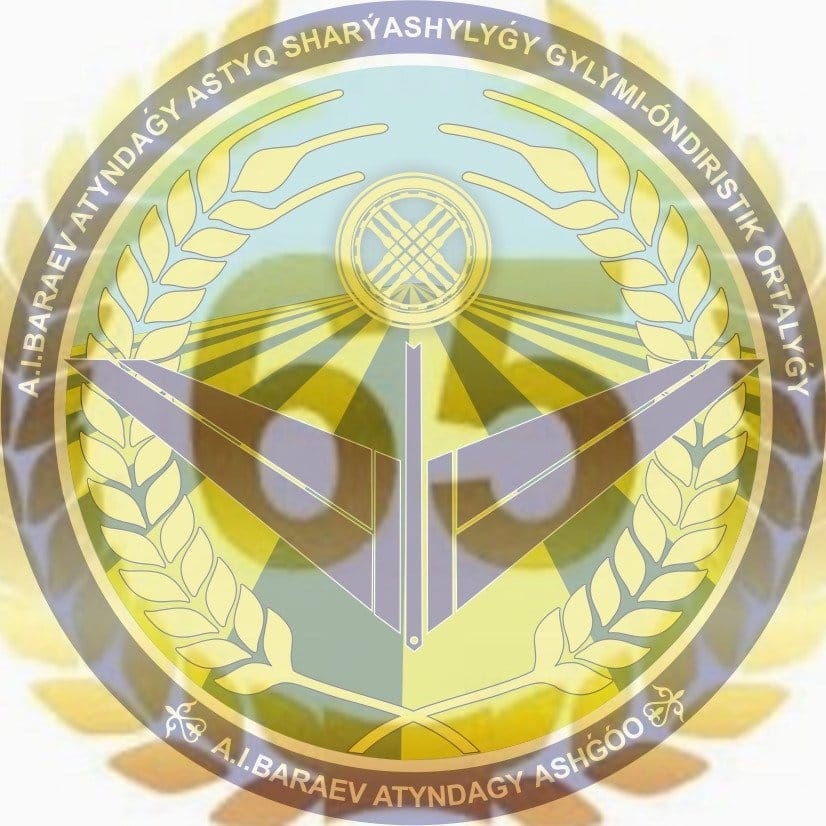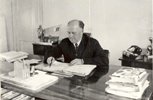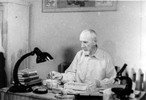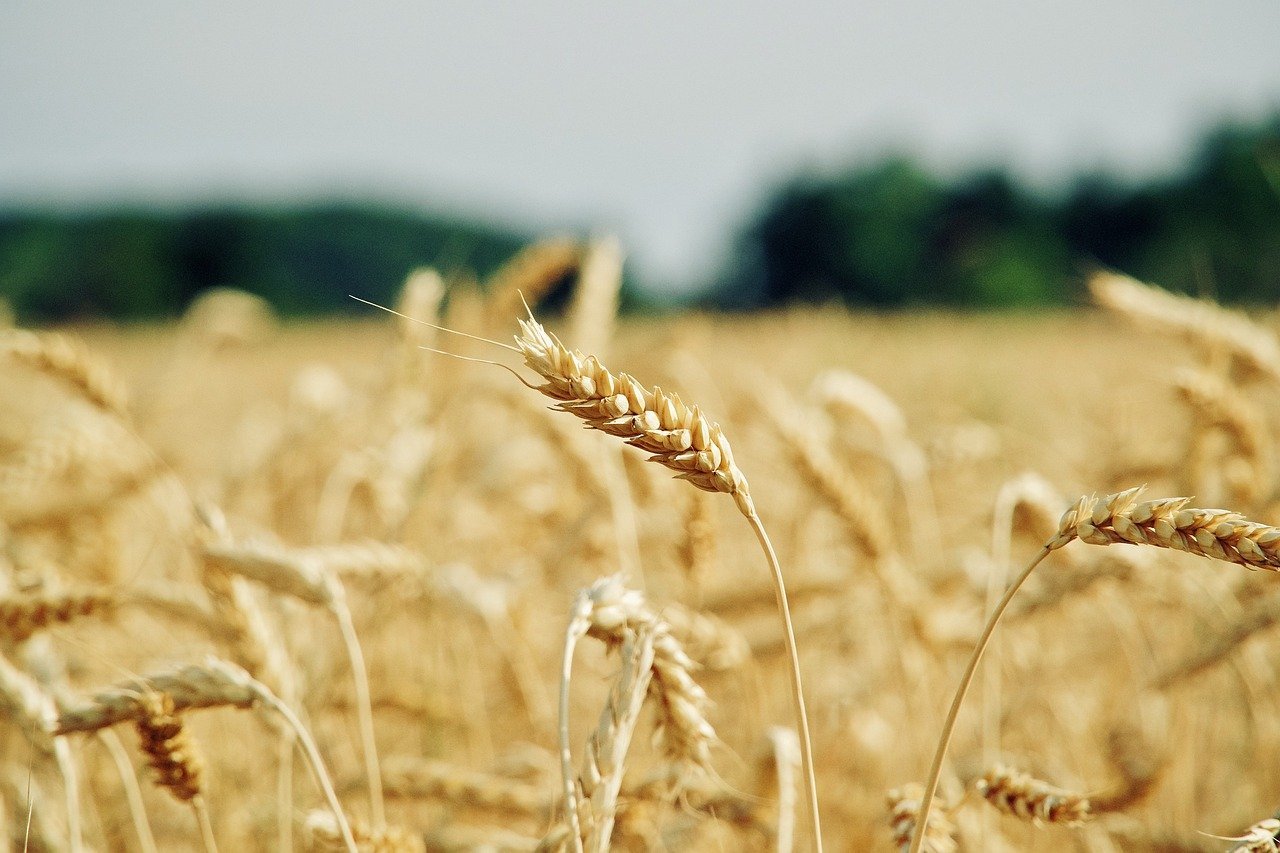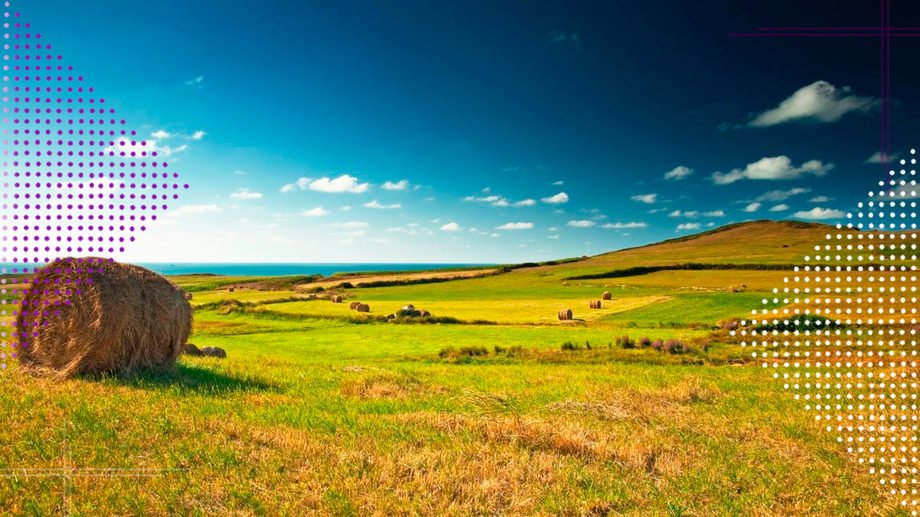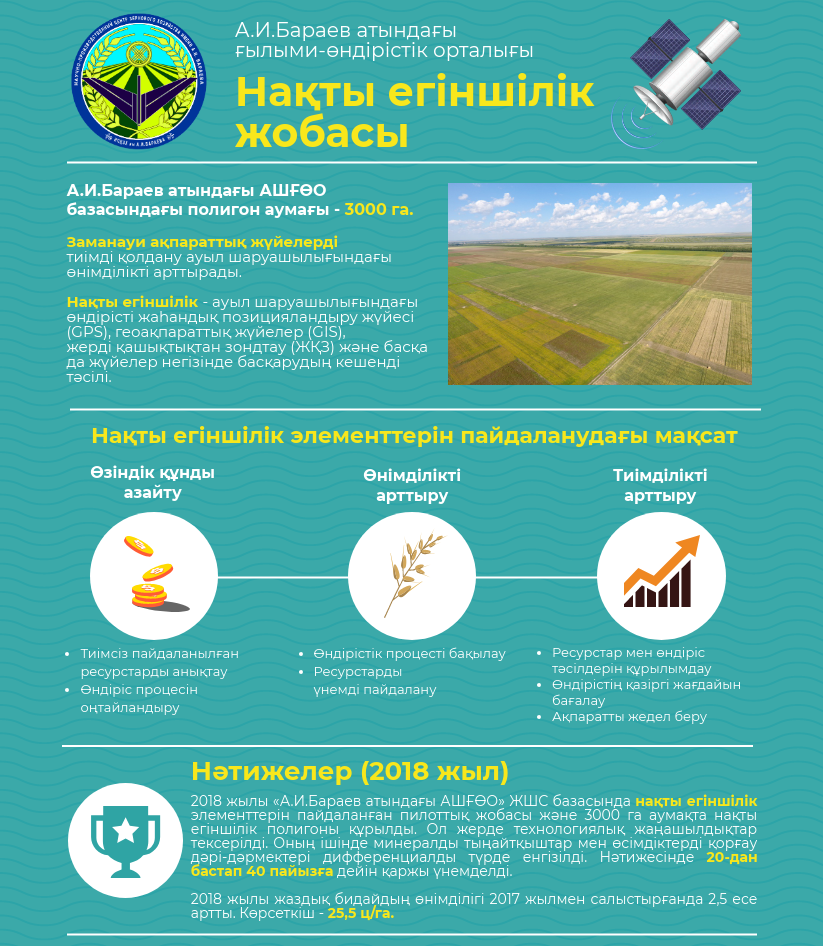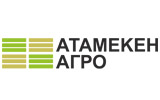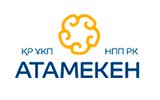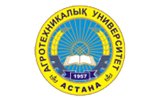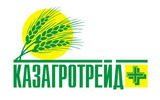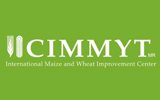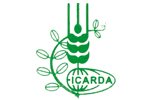Wheat breeding department
Departments and laboratories / Wheat Breeding Department
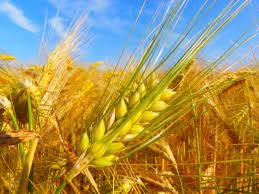
The organization of breeding work in Northern Kazakhstan was started in 1936 with the formation of the Shortandy experimental station by breeder V. P. Kuzmin. Valentin Petrovich started breeding with many crops (about 29), but the main ones were: spring soft and hard wheat, winter rye, potatoes, flax, sunflower, millet, buckwheat, ginger, corn, barley, oats, spelt, sorghum, peas, chickpeas, beans, soy, lentils, alfalfa, lelemantia, oilseed poppy, Chinese radish, safflower, hemp, etc. In the first two decades, he carefully studied the local breads and their botanical composition, as well as the VIR collection. As a result of studying the local forms of wheat and varieties of non-regional origin, the ecological type of the variety for this region was determined. The climatic conditions of the northern regions of Kazakhstan were more suitable for wheat of the West Siberian type. This ecological type of wheat, established by N. L. Udolskaya, is characterized by a long period of tillering and emergence into the tube, a spreading and semi-spreading bush shape, a powerful root system, dark green color and leaf pubescence. After waiting out the unfavorable conditions of spring and early summer, such varieties successfully develop at a later time, timing the earing phase to the maximum summer precipitation in mid-summer.
For the first time in Northern Kazakhstan, V. P. Kuzmin began crossing spring wheat with winter wheat as the most important source of productivity and cold resistance, used the selection of drought-resistant genotypes by the number of germ roots and introduced the term “rootedness”. The first variety of synthetic breeding in the North of Kazakhstan was Akmolinka 1. In 1945, Akmolinka 1 was zoned in the Northern regions of Kazakhstan and sown for more than 20 years. The acreage of Akmolinka 1 reached 3.5 million hectares.
Good results were obtained when high-yielding wheat varieties of local breeding were taken as the female parent during hybridization, in the genotype of which, in the process of step-by-step crosses, a number of valuable traits, including grain quality, were accumulated. In order to improve the technological qualities of the grain while maintaining high yield properties and climatic endurance, these varieties were crossed with the best varieties of winter and spring wheat of the world breeding.
One of the first varieties of strong spring soft wheat in the North of Kazakhstan was the Tselinogradka variety, obtained from crossing the hybrid variety of spring soft wheat Milturum 45 (ARIGF) with winter wheat Kooperatorka (Ukraine). The Tselinogradka variety, which is the product of complex crosses, combines the positive properties of the best varieties of spring and winter wheat in Canada, Ukraine, Siberia and Kazakhstan.
In the future, under the leadership of Academician V. P. Kuzmin, varieties of spring soft wheat were created – Akmolinka 1, Akmolinka 5, Snegurka, Shortandinka, Tselinogradka, Pirotrix 28, Tselinnaya 21.
At the present stage of scientific and technological progress in agriculture, the role and importance of the variety has significantly increased. High demands are placed on the varieties. The variety must meet the modern level of mechanization, chemization, and the entire complex of agrotechnical techniques aimed at its cultivation. Otherwise, the material and spiritual costs of its cultivation will not be recouped by the products or the cost will be too high.
The talented breeder V. K. Movchan successfully applied the method of crossing winter varieties with spring varieties, tested for the first time in Northern Kazakhstan by academician V. P. Kuzmin when creating varieties of spring soft wheat Astana and Akmola 2. Movchan V. K. transformed winter wheat varieties into spring wheat, and then used them as mother forms when crossing.
In 1998, a new variety of Akmola 2 was approved for use in the Akmola and North Kazakhstan regions. The variety was developed by crossing the transformed line Lutescens M 808 (from the winter variety Mironovskaya 808) with the spring variety Tselinnaya 60 and combines high productivity and drought resistance. The maximum yield obtained in the competitive variety testing in 2011 was 42.2 c/ha. According to the 2008 environmental test in the North Kazakhstan AES, the Akmola 2 variety exceeded the Omsk 19 standard in yield by 1.3 c / ha, forming a yield of 28.7 c/ha.
The variety is medium-ripe, resistant to lodging, has high flour-baking qualities of grain: gluten content-28-33%, protein-15-17%, flour strength-304-471 e. a., the overall baking score-4.0-4.5 points. The variety is accepted as a standard in the Akmola region. In 2018, the acreage under the variety Akmola 2 amounted to more than 1.3 million hectares.
The Astana variety was obtained by crossing I-2959 on Tselinnaya 90 (Lutescens I-2959 was obtained from the winter wheat variety Ilyichevka). Astana matures 1-3 days earlier than the standard of Akmola 2. The variety successfully combines precocity and yield. The maximum yield obtained in the competitive variety testing in 2011 was 37.1 c / ha. According to the environmental test in 2008, in the North Kazakhstan AES, Astana exceeded the Omsk 19 standard in yield by 1.1 c / ha, forming a yield of 28.5 c/ha.
The Astana variety is favorably distinguished by drought resistance, strong aligned stem, friendly maturation and resistance to dusty smut and hidden stem pests, has high grain quality: cup weight-780-810 g/l, grain hardness-60-70%, gluten content-31-38%, protein-15-17%, flour strength-300-500 e. a., overall baking score-4.3 - 4.8 points. The acreage under the Astana variety in 2018 amounted to 839 thousand hectares. Since 2004, the variety has been approved for use in the Akmola and North Kazakhstan regions.
When breeding the Shortandinskaya 95 improved variety (A. S. Ermilov, R. N. Okovitaya, A. T. Babkenov, etc.), the wheat varieties Tselinnaya 21, Pirotrix 28, created by academician V. P. Kuzmin, were used.
This variety was obtained by mass selection from a hybrid population of Pirotrix 28 / Justin / / Tselinnaya 21 / 3 / Tselinnaya 60 / Lutescens 57-76. A medium-late ripening variety. The growing season is 95-100 days, has a complex of economically valuable characteristics: high-yielding, drought-resistant, coarse-grained, resistant to lodging, resistance to diseases and pests at the level of the Virgin Jubilee standard. A characteristic feature is a well-developed leaf apparatus and a strong straw. According to the environmental test in the North Kazakhstan AES, when sowing by steam for 2007-2008, the yield of Shortandinskaya 95 improved was 23.3 c / ha, which is higher by 1.7 c/ha than that of the Omsk 19 standard. The maximum yield obtained was 45.1 c/ha in 2011. The variety Shortandinskaya 95 improved forms the content of vitreous at the level of 60-70%, the cup weight-780-800 g/l, the protein content-15-16%, the content of raw gluten-30-32%, the quality of gluten-60-75 unit FDM. In terms of technological and baking qualities, it is not inferior to the standard variety Tselinnaya Yubileynaya and belongs to the group of “strong” wheat. Acreage in 2018 reached 1.2 million hectares. Since 2006, the variety has been included in the State Register of Breeding Achievements approved for use in the Republic of Kazakhstan in the Akmola and North Kazakhstan regions.
V. P. Kuzmin wrote that “ ... to create a good material in terms of plasticity and fitness allows the selection and evaluation of varieties on variable agrotechnical backgrounds at different sowing dates: a) pure fallow, with optimal sowing times, and b) early sowing in the finch…”.
Currently, the department of spring soft wheat breeding is studying the issues of ecological plasticity and stability of newly created varieties, the study of promising and hybrid material is carried out on three agricultural backgrounds, contrasting in water and food regimes of the soil. Saturating crosses are carried out in order to create a starting material that is resistant to brown and stem rust and septoria. At the final stages of the breeding process in the KSI nursery, several promising lines are tested that are resistant to brown and stem rust, as well as combining high yield, drought resistance, early maturity and grain quality.
In 2018, a new variety of spring soft wheat was created called-Taimas, which means in Kazakh – steadily going to the goal.
This variety was obtained by crossing the Duet variety on the 101/94-1 line. Variety-erythrospermum (erythrospermum). The variety is of the medium-ripened type of maturation. The variety is resistant to drought in all phases of development, which ensures high productivity. Resistant to lodging. Moderately resistant to brown rust. The variety is high-yielding, on average, for three years of testing in the KSI nursery, it formed a yield of 25.5 c / ha, exceeding the standard of Akmola 2 by 2.5 c / ha. In the production variety test, the Taimas variety exceeded the standard of Akmola 2 by 6.3 c / ha, with the yield of the standard variety of 21.7 c / ha. According to the environmental test in 2018 in the “North Kazakhstan AES” LLP, the yield of the new variety averaged 35.2 c / ha, which is 2.5 c / ha higher than that of the standard variety Omskaya 35. In terms of grain quality, the variety exceeds the standard of Akmola 2 in terms of such indicators as protein content-15.7 %, gluten content-32.3 %, specific work of dough deformation-297 e. a., in the standard variety of Akmola 2: 13.8%; 30.1 %; 277 e. a., respectively. According to other quality indicators, it is at the level of Akmola 2: cup weight-785 g/l, grain hardness-54 %, gluten quality-80 units FDM and the overall baking score – 4.6 points; the standard – 793 g / l; 53 %; 76 units FDM and 4.5 points, respectively. The variety is resistant to shedding and is suitable for mechanized harvesting. It is promising for cultivation in the Northern regions of Kazakhstan.
Thus, for 85 years of breeding work in the SPC GF named after A. I. Barayev for spring wheat, 33 varieties were created and zoned. Scientific application and purposeful use of the rich heritage left by Academician V. P. Kuzmin allows breeders to create highly productive varieties of this valuable crop.
Research and innovation activities
Unfortunately, the varieties of spring wheat cultivated in production, including the varieties of our Center, do not consistently form the yield and quality of grain in different weather conditions in years. Almost all spring wheat varieties approved for use in Northern Kazakhstan are susceptible to rust diseases and septoria.
In this regard, to provide agricultural producers with competitive, productive, high-quality grain varieties of spring wheat adapted to the conditions of our region, it is necessary:
1) Creation of precocious varieties of spring wheat.
2) Creating varieties of spring wheat with high grain quality.
3) Creation of spring wheat varieties resistant to rust diseases and septoria.
In this regard, the creation of high-yielding early-ripening wheat varieties with high grain quality is a very urgent task.
Achievements of breeding work
The effectiveness of breeding work | ||||
No. | Varieties | Ripeness type | Place of implementation | Year |
1 | Akmolinka 1 | middle-late | North regions of Kazakhstan | 1945 |
2 | Shortandinka | middle-late | North regions of Kazakhstan | 1951 |
3 | Snegurka | middle-late | North regions of Kazakhstan | 1957 |
4 | Tselinogradka | middle-late | Tselinograd region | 1967 |
5 | Pirotrix 28 | middle-late | Novosibirsk region (Russia) | 1973 |
6 | Shortandinskaya 25 | mid ripening | Turgai region | 1976 |
7 | Tselinnaya 20 | middle-late | Altai Territory (Russia) | 1978 |
8 | Tselinnaya 21 | middle-late | Kostanay and East Kazakhstan regions | 1980 |
9 | Tselinnaya 26 | mid ripening | Omsk (Russia) and East Kazakhstan region | 1986 |
10 | Tselinnaya 60 | mid ripening | Altai Territory (Russia) | 1988 |
11 | Tselinnayayubileinaya | middle-late | Akmola, North Kazakhstan, Kostanay, Pavlodar regions. | 1988 |
12 | Erythrospermum 35 | middle-late | Akmola, Kostanay, North Kazakhstan, Karaganda regions | 1991 |
13 | Tselinnaya24 | middle-early | Akmola region | 1993 |
14 | Tselinnaya 3с | mid ripening | Akmola, North Kazakhstan, Kostanay regions | 1996 |
15 | Akmola 2 | mid ripening | Akmola, North Kazakhstan regions | 1998 |
16 | Kenzhegali | middle-late | Akmola region | 1998 |
17 | Astana | middle-early | Akmola, North Kazakhstan regions | 2004 |
18 | Shortandinskaya 95 improved | middle-late | Akmola, North Kazakhstan regions | 2006 |
19 | Astana 2 | mid ripening | North Kazakhstan, East Kazakhstan regions | 2008 |
20 | Baiterek | mid ripening | East Kazakhstan regions | 2008 |
21 | Tselina 50 | mid ripening | Akmola, Karaganda regions | 2010 |
22 | Shortandinskaya 2007 | mid ripening | West Kazakhstan region | 2012 |
23 | Asyl sapa | mid ripening | Akmola, North Kazakhstan regions | 2015 |
24 | Shortandinskaya 2012 | middle-early | Akmola, Kostanay, Pavlodar, North Kazakhstan regions | 2015 |
25 | Tauelsizdik 20 | middle-early | Akmola, Kostanay, North Kazakhstan regions | 2016 |
26 | Oral | mid ripening | West Kazakhstan region | 2016 |
27 | Shortandinskaya 2014 | mid ripening | Акмолинская, Костанайская, Северо-Казахстанская области | 2017 |
28 | SID-88 | middle-late | Akmola, Karaganda, Kostanay and North Kazakhstan regions | 1993 |
29 | Damsinskaya 90 | mid ripening | Akmola, East Kazakhstan, Pavlodar and North Kazakhstan regions | 1995 |
30 | Damsinskaya yantarnaya | mid ripening | North Kazakhstan region | 2008 |
31 | Korona | middle-early | Akmola and Karaganda regions | 2010 |
32 | Lavina | mid ripening | Akmola region | 2015 |
33 | Damsinskaya yubileinaya | middle-early | Akmola and North Kazakhstan regions | 2017 |
Spring wheat varieties of breeding in the “SPC GF named after A. I. Barayev” LLP were cultivated on an area of more than 3.5 million hectares in 2020. In the Akmola region, the varieties of “SPC GF named after A. I. Barayev” LLP occupy 70.3%, in North Kazakhstan-32.2%, in Karaganda-12.8% and in Kostanay region-4.0%, in Pavlodar region-5.5% of the sown area of wheat.
Crop | Varieties | Akmola region | North Kazakhstan | Karaganda region | Kostanay region | Pavlodar region | Total |
Spring soft wheat | Astana | 773,6 | 319,5 | 1,2 | 2,7 | 8,1 | 1105,1 |
Shortandinskaya 95 improved | 804,4 | 144,3 | 0,4 | 84,2 | 27,4 | 1060,7 | |
Akmola 2 | 726,7 | 79,0 | - | 34,5 | - | 840,2 | |
Tselina 50 | - | - | 1,4 | - | - | 1,4 | |
Astana 2 | 202,4 | 87,6 | - | - | - | 290,0 | |
Shortandinskaya 2012 | 47,6 | 31,7 | 85,5 | 11,2 | - | 176,0 | |
Asyl sapa | 3,5 | - | - | - | - | 3,5 | |
Spring durum wheat | Damsinskaya 90 | 14,6 | 6,2 | - | - | - | 20,8 |
Korona | 7,8 | - | - | - | - | 7,8 | |
Damsinskaya yantarnaya | 20,1 | 74,6 | - | 2,5 | - | 97,2 | |
Total | 2600,7 | 742,9 | 88,5 | 135,1 | 35,5 | 3602,7 | |
Total for the region | 3698,7 | 2303,9 | 691,1 | 3439,2 | 643,4 | 10 776,3 | |
% of our varieties | 70,3 | 32,2 | 12,8 | 4,0 | 5,5 | 33,4 | |
The department is equipped with the necessary devices and equipment for high-quality research:
breeding seeders-SSFC-7, SCS 6-10
breeding combines-WINTERSTEIGER Classic and Delta
Laboratory seed cleaning and sorting machine-SLN 3
Microscope – Leica
thermostat for seed germination, etc.
Department’s structure
According to the organizational structure, the department consists of 4 laboratories and 1 group:
1) Laboratory of spring soft wheat breeding;
2) Laboratory of spring durum wheat breeding;
3) Laboratory of plant immunity to diseases;
4) Laboratory of genetic resources of grain crops;
5) Group of primary seed production of spring wheat.
Wheat breeding department
According to the staff schedule, the department has 27 employees, including 12 researchers, including 2 Candidates of Agricultural Sciences, 1 Doctor of PhD, 4 masters and 12 laboratory assistants. They are studied in the doctoral program 1, in the master's program 2 people.
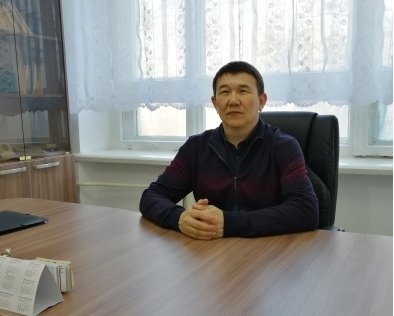
Babkenov Adylkhan Temirkhanovich, PhD in Agricultural sciences
Head of Wheat Breeding Department
Office No. 22, cell-phone: +7 747 445 31 34
e-mail:
Main research areas
Breeding and seed production of spring wheat for productivity, grain quality and resistance to abiotic and biotic environmental factors in Northern Kazakhstan.
Current research projects
2021-2023-project within the grant funding of the Ministry of Agriculture of the Republic of Kazakhstan “Breeding of competitive, productive, high-quality grain varieties of spring wheat for the conditions of Northern Kazakhstan”.
Education
1981-1986 Tselinograd Agricultural Institute - Higher education;
In 2005 received the PhD of Agricultural Sciences in the specialty "Breeding and seed production" (RIA of the South-East, Saratov, Russia).
Work experience
since 1988- up to the present day works in the “SPC GF named after A. I. Barayev” LLP
since 2003 - Head of the wheat breeding department.
Qualification improvement
1999 – International Center ICARDA, Siria
2000 – International Wheat and Corn Improvement Center CIMMYT, Mexico
2013 – Moscow Agricultural Academy named after Timiryazev, Moscow, Russia
2016-2017 – Institute of Genetics and Cytology of the National Academy of Sciences of Belarus, Minsk, Belarus.
Publications
The author has more than 100 scientific works. The most important in the presented areas:
1) A.T.Babkenov, K.M. Mussynov, D.S. Bazilova, O.I. Zaitsevaand Y. K. Kairzhanov. Productivity of spring soft wheat cultivars grown in Northern Kazaкhstan // ECOLOGY, ENVIRONMENT AND CONSERVATION VOL. 23 (2) : 2017 РР. 786-794. ISSN 0971–765X. (SCOPUS IF – 0,141, процентиль – 8, Web of Science – Q4, Индия). https://www.mendeley.com/authors/57190402536/
2) Utebayev M, Dashkevich S, Babkenov A, Shtefan G, Fahrudenova I, Bayahmetova S, Sharipova B, Kaskarbayev Z, Shavrukov Y. Application of gliadin polymorphism for pedigree analysis in common wheat (Triticumaestivum L.) from Northern Kazakhstan // ActaPhysiologiaePlantarum. 38.204. (SCOPUS IF=1,5, процентиль – 75, Web of Science – Q2, Польша) DOI:10.1007/s11738-016-2209-4
3) Zaitseva O. I., Burakova A. A., Babkenov A. T., Babkenova S. A., Utebaev M. U., V Lemesh. A. Allelic diversity of high-molecular-weight glutenin genes in soft wheat//Cytology and genetics. - No. 6. - 2017. - Volume 51. - p. 22-31. ISSN 0095-4527 (SCOPUS IF-0.379, percentile-16, Web of Science-Q4-Ukraine). DOI: 10.3103/S0095452717060123.
4) Babkenova, S. A., Babkenov, A. T., Kolomiets, T. M., Skolotneva, E. S., &Divashuk, M. G. (2017). Molecular genetic tagging of wheat varieties genes resistant to Septoriatritici in northern Kazakhstan.International Journal of Green Pharmacy, 11(3), S430–S437. (SCOPUS IF=1,681, процентиль – 33, Web of Science – Q3, Индия) https://www.mendeley.com/catalogue/16d1aebb-0859-3bf8-8630-aa687a650417/
5) Adylkhan Temirhanovich Babkenov, Sandukash Amantaevna Babkenova, Kenzhe Kozhakhmetovich Abdullayev, Yelzhas Konspekovich Kairzhanov. Breeding Spring Soft Wheat for Productivity, Grain Quality, and Resistance to Adverse External Factors in Nothern Kazakhstan // J. Ecol. Eng. 2020; 21(6):8–12. (IF=0,79; SCOPUS процентиль – 38, Web of Science – Q2, Польша) DOI: https://doi.org/10.12911/22998993/123160
6) Babkenov A. T., Babkenova S. A., Kairzhanov E. K. Screening of a collection of spring soft wheat varieties for precocity and high grain quality in the conditions of Northern Kazakhstan // Theoretical and applied problems of the agro-industrial complex. 2017. No. 3 (32). pp. 12-16.
7) S. A. Babkenova, A. T. Babkenov. The harmfulness of septoria and brown rust on the yield of spring soft wheat varieties in the conditions of the Akmola region// Izvestiya NAS RK. 2017.- 3(39).- Pp. 62-65.
Protection documents
1) Patent No. 149 for the wheat variety Shortandinskaya 95 improved from 18.08.2010; 2) Patent No. 227 for the wheat variety Akmolinskaya niva from 13.04.2012; 3) Patent No. 229 for the wheat variety Shortandinskaya 2007 from 13.04.2012; 4) Patent No. 346 for the wheat variety Tselina 50 from 24.06.2013; 5) Patent No. 347 for the wheat variety Asyl Sapa from 24.06.2013;6) Patent No. 663 for wheat variety Vladimir from 19.05.2016; 7) Patent No. 650 for wheat variety Shortandinskaya 2012 from 21.04.2016; 8) Patent No. 715 for wheat variety Tselinnaya niva from 21.11.2016; 9) Patent No. 726 for the Tselinnaya 2008 wheat variety dated 02.03.2017; 10) Patent No. 811 for the Shortandinskaya 2014 wheat variety dated 26.02.2018;
Contacts
Babkenov A.T. cell-phone: 8 747 445 31 34, e-mail: babkenov64@mail.ru.



